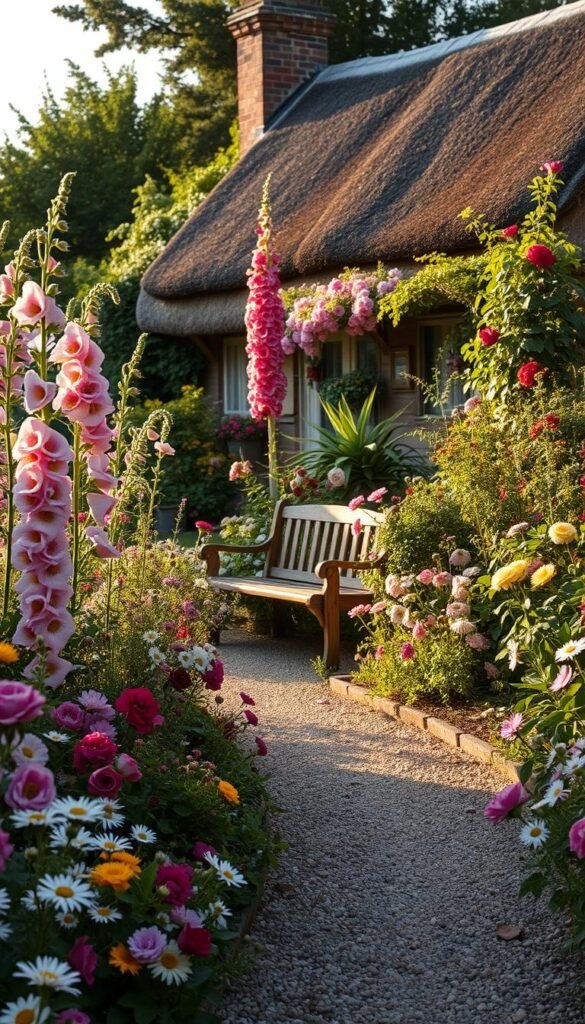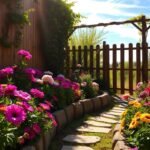Imagine stepping into a living painting where flowers dance with herbs and vines tumble over weathered stone. This is the magic of traditional romantic landscapes, blending careful planning with nature’s free-spirited beauty. Once practical plots for medieval families, these spaces evolved into artistic expressions during the Victorian era, championed by visionaries like Gertrude Jekyll.
Today’s gardeners are rediscovering this style, merging old-world charm with modern cottagecore aesthetic trends. Climbing roses frame doorways while lavender spills onto pathways, creating scenes that feel both intentional and wild. The secret lies in balancing structure with surprises – think foxgloves peeking through picket fences or thyme carpeting between stepping stones.
What makes these spaces endure? They adapt beautifully to any size yard, from sprawling estates to cozy urban corners. You’ll learn how to layer textures, choose plants that work double duty, and create that lived-in elegance that whispers stories of seasons past. Whether you’re drawn to hollyhocks or herbs, every choice adds to the tapestry.
Ready to craft your own slice of pastoral paradise? Let’s explore the foundations that turn ordinary yards into enchanted retreats, blending history’s wisdom with today’s creative flair.
Embracing the English Cottage Garden Aesthetic
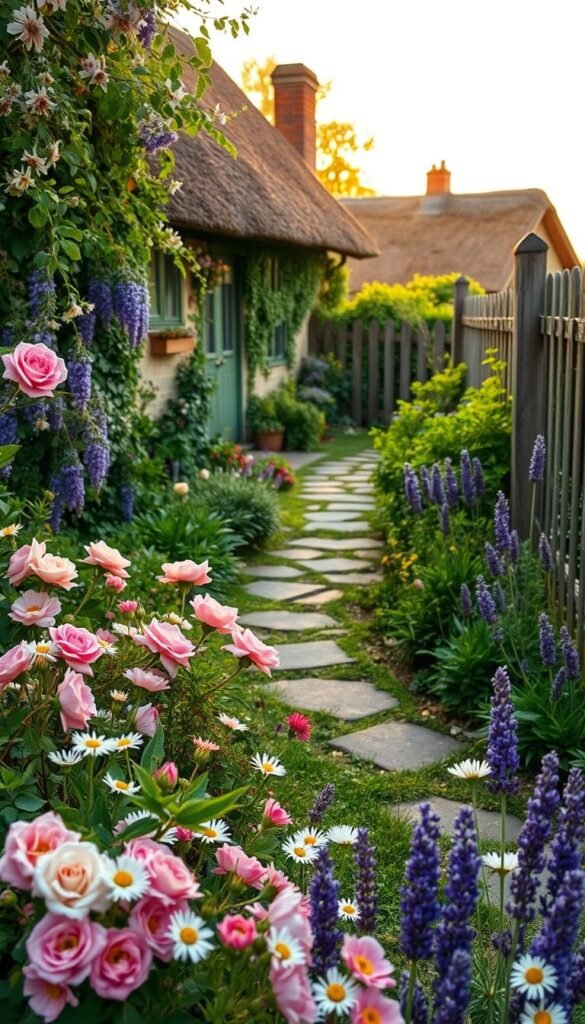
What if your backyard could feel like a storybook come to life? This timeless approach thrives on charm over perfection, blending history with nature’s spontaneity. Let’s explore how humble beginnings and modern tastes shaped this beloved look.
Roots in Necessity
Centuries ago, rural families mixed veggies with flowers to maximize small plots. Medicinal herbs grew beside roses, while fruit trees shaded parsley patches. These practical spaces laid the groundwork for today’s free-flowing designs.
“People want relaxed spaces that age gracefully,” says designer Jo Thompson. “Your plot can feel curated yet wild – like it’s always been there.”
Modern Meets Heritage
Today’s versions keep the soul of traditional layouts but add eco-friendly twists. Designers use native plants and rainwater systems while maintaining that just-discovered vibe. The table below shows how old and new approaches compare:
| Aspect | Historical Approach | Modern Adaptation |
|---|---|---|
| Layout | Mixed edible/ornamental | Wildlife-friendly zones |
| Plant Selection | Local varieties | Drought-resistant species |
| Maintenance | Daily care | Self-seeding blooms |
This style’s revival proves beauty doesn’t require rigid rules. Let climbing vines frame your porch or let mint spill onto walkways – your space becomes a living tapestry that changes with the seasons.
Understanding Your Garden Space and Setting
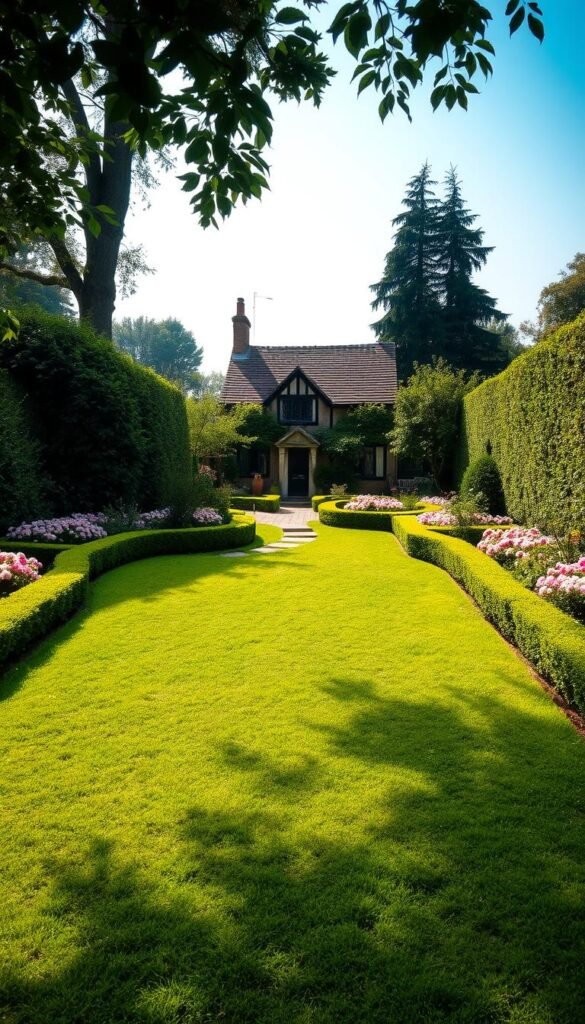
Before planting a single seed, successful gardens begin with observation. Walk your land at different times to see where sunlight lingers or where water pools after rain. These patterns shape your design more than any catalog ever could.
“Your site tells its own story – learn to read it,” advises designer Xa Tollemache. “Sometimes subtracting elements creates better flow than adding new features.”
Landscape Assessment Essentials
Start by testing your soil’s texture and pH. Sandy soils drain fast but need more nutrients. Clay holds moisture but may drown plant roots. Most flowering plants thrive in slightly acidic earth (6.0-6.5 pH).
Notice natural slopes – they’re free drainage solutions. Steep areas become perfect spots for rockeries, while low zones can host moisture-loving ferns. Sheltered corners protect delicate blooms from harsh winds.
| Feature | Assessment Steps | Design Solutions |
|---|---|---|
| Soil Quality | Test pH, texture, organic matter | Amend with compost or sand |
| Drainage Patterns | Observe after rainfall | Create swales or raised beds |
| Sun Exposure | Track light every 2 hours | Group plants by shade tolerance |
Your home’s architecture offers clues too. A rustic cottage pairs with loose plantings, while modern structures might need cleaner lines. Let pathways mirror your home’s entryway style for harmony.
Local climate dictates plant choices more than trends. Check USDA zones and frost dates, but also microclimates – that south-facing wall could let you grow figs in zone 6!
Selecting the Perfect Plants and Flowers
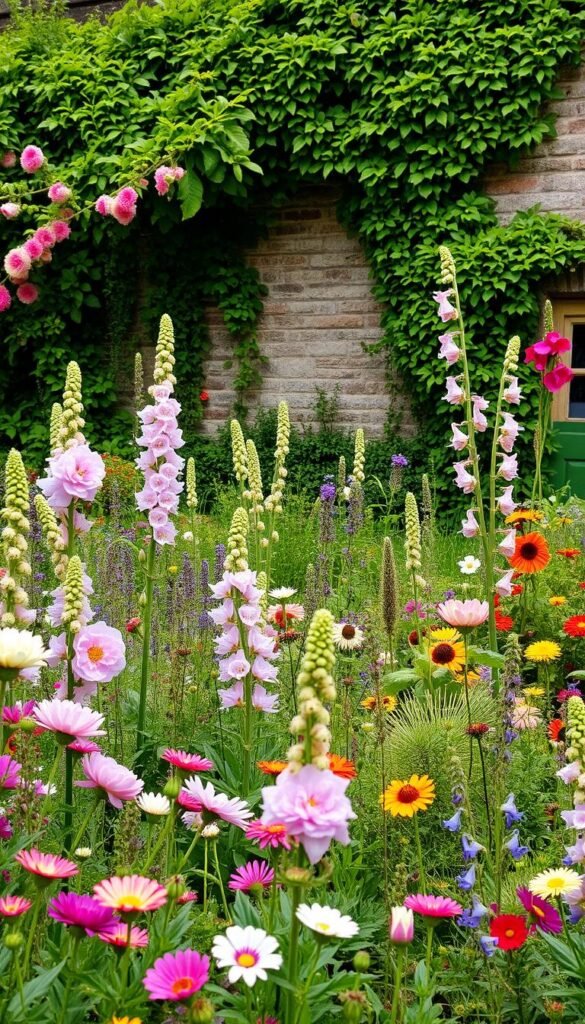
Picture this: Your garden bursting with colors that shift with the seasons. The right mix of plants creates layers of texture and scent, forming the backbone of a thriving cottage-style space. Let’s explore how to choose varieties that work hard while looking effortless.
Must-Have Staples for Timeless Beauty
Start with perennials that anchor your design. Peonies offer lush blooms in late spring, while delphiniums add vertical drama. Lupines fix nitrogen in the soil, making them both pretty and practical. Check this quick guide to classic favorites:
| Plant | Bloom Time | Height | Care Tip |
|---|---|---|---|
| Foxglove | Early Summer | 3-5 ft | Partial shade |
| Hollyhock | Mid-Summer | 6-8 ft | Stake stems |
| Lavender | Summer | 1-3 ft | Full sun |
Mixing Function and Charm
Herbs like thyme and sage edge pathways while repelling pests. Let mint spill from containers – its scent refreshes the air. Climbers transform fences into living walls. Rambling roses need minimal pruning, and honeysuckle attracts hummingbirds.
Pair early bloomers with late-season stars for constant color. Irises shine in spring, while asters take over in fall. Remember: Self-seeding flowers like poppies keep your garden looking delightfully unplanned.
English Cottage Garden Inspiration: Key Elements of a Classic Design
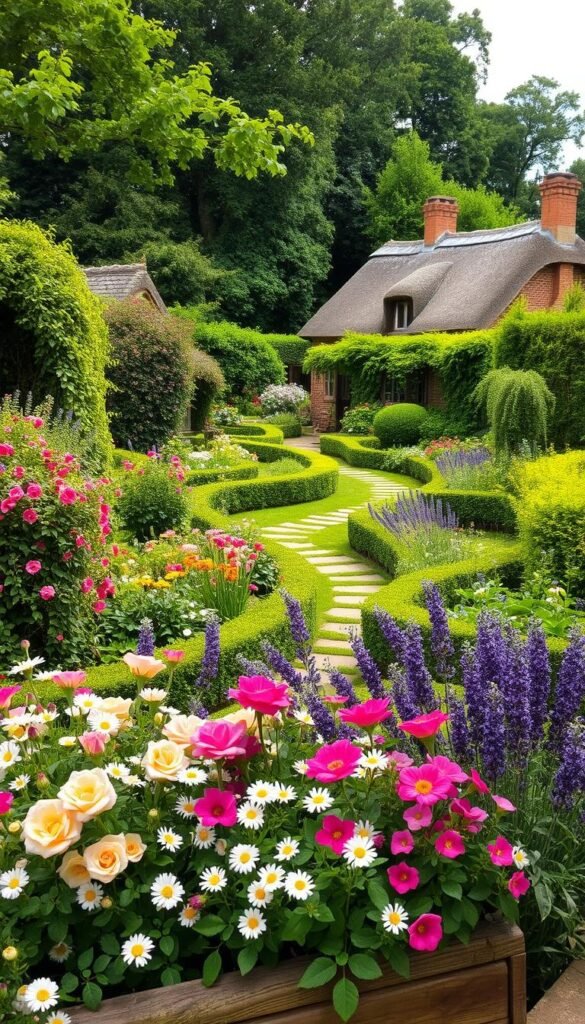
How do you make a new space feel centuries old? The magic lies in organized chaos – designs that look wild but follow smart rules. Start by softening modern edges with billowing shrubs or climbing hydrangeas. These natural screens hide fences or garages, creating that “found it this way” charm.
Plant like nature’s assistant. Scatter seeds in drifts, letting poppies mingle with daisies. Tall foxgloves behind low-growing thyme add depth, while repeating colors (like purple salvias) tie the scene together. Designer Julie Farris suggests:
“Let plants spill onto paths – a little messiness invites exploration.”
Balance is key. Place a weathered bench or stone urn as focal points amid the blooms. Leave narrow gaps between plants for airflow and easy care. Mix early tulips with late-blooming asters to keep interest year-round.
Your secret weapon? Vertical layers. Train roses over arches, let clematis climb through shrubs, and tuck ferns beneath flowering stems. This creates that lush, lived-in look where every glance reveals new details.
Remember: True cottage-style beauty comes from relaxed structure. Allow self-seeding flowers to wander, and watch your space transform into a tapestry that feels both crafted and wild.
Incorporating Classic Design Features
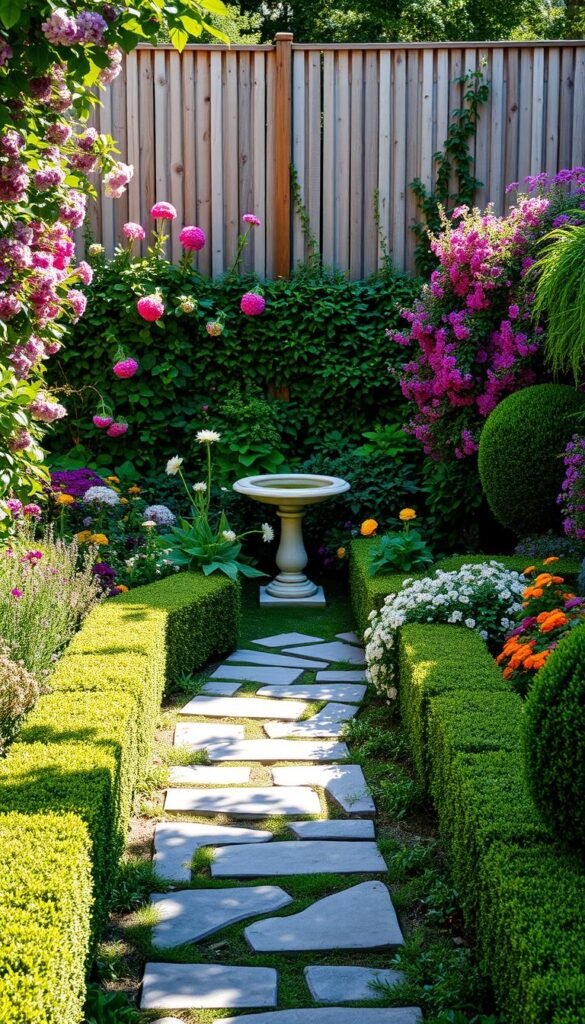
The bones of a timeless outdoor space lie in its structural elements. Thoughtful hardscaping creates visual anchors that let plants shine while guiding visitors through your landscape. Start by choosing materials that whisper stories of seasons past.
Traditional Hardscaping and Stone Elements
Local stone transforms functional features into art. Weathered limestone steps develop mossy edges over time, while reclaimed brick borders soften with lichen. For raised beds, stack flat stones loosely – their crevices become homes for creeping thyme or alpine strawberries.
Consider these durable options:
- Fieldstone retaining walls that double as seating
- Crushed gravel walkways that crunch underfoot
- Dry-stack stone benches nestled among blooms
Architectural Details and Pathways
Meandering paths should feel discovered, not forced. Lay flagstones with generous gaps for self-sowing violas or chamomile. For gravel routes, edge with bending steel straps that mimic old farm tools. Designer Ben Pentreath notes:
“Great pathways balance direction with delight – let plants occasionally breach the edges.”
Wooden arbors draped in clematis create living thresholds. Use chestnut paling fences as backdrops for climbing roses, their weathered silver tones complementing stone features. These elements work together to frame your garden like a cherished painting.
Creating a Relaxed and Inviting Atmosphere
What transforms a collection of plants into a soul-nourishing retreat? It’s the art of slowing down – designing spaces that invite you to linger as seasons unfold. Start by tucking a weathered bench under climbing roses or creating hidden nooks with fragrant herbs.
Curved pathways lined with lavender encourage leisurely strolls, while bubbling stone fountains add soothing background music. Designer Julie Moir Messervy suggests:
“Let your space whisper secrets – a partially visible sculpture or unexpected bloom cluster keeps curiosity alive.”
Engage all senses with these features:
| Element | Purpose | Plant Pairing |
|---|---|---|
| Rustic arbor | Creates shaded resting spots | Honeysuckle or jasmine |
| Gravel seating area | Encourages mindful observation | Self-seeding poppies |
| Herb spiral | Releases scent when brushed | Thyme, lemon balm |
Allow plants to age gracefully – dried hydrangea heads add winter texture, while fallen leaves become natural mulch. This approach reduces upkeep and celebrates nature’s cycles, making your space feel lived-in rather than manicured.
Your outdoor haven becomes a bridge between home and wilderness. By blending structured seating with wilder edges, you’ll create corners that refresh the spirit every time you step outside.
Integrating Climbing and Vertical Interest
Ever wondered how to make your space feel taller and more alive? Vertical layers add depth while maximizing every inch of your plot. These living curtains soften walls and create natural privacy screens that evolve with the seasons.
Utilizing Climbing Roses and Wisteria
Start with rambling roses like ‘New Dawn’ – their flexible canes easily train over arches or fences. Pair them with wisteria for staggered blooms: roses shine in summer, while wisteria’s purple clusters arrive in spring. Designer Dan Pearson suggests:
“Let climbers grow through each other. A rose threading through wisteria creates unexpected beauty while sharing support.”
Choose structures that age gracefully. Rustic metal obelisks suit compact spaces, while wooden pergolas handle vigorous growers. This table helps match plants to your needs:
| Plant | Best For | Bloom Period | Support Type |
|---|---|---|---|
| Climbing Roses | Sunny Walls | June-September | Freestanding Arches |
| Wisteria | Overhead Canopies | April-May | Steel Cables |
| Clematis | Fence Coverage | Varies by Species | Mesh Panels |
| Honeysuckle | Fragrant Screens | Summer Nights | Trellis Systems |
Train new growth horizontally along wires – this encourages more flowers along the stems. For quick coverage, plant fast-growers like Rosa ‘American Pillar’ near sheds or bare walls. Their thorny stems even deter trespassers!
Vertical layers solve multiple challenges. They hide AC units, reduce street noise, and create shaded seating areas. Best part? Once established, these climbers thrive with minimal pruning – just occasional guidance for wayward branches.
Modern Techniques for Maintaining a Cottage Garden
Maintaining that effortless charm doesn’t mean endless chores. Smart strategies help your space thrive while keeping weekends free for enjoyment. It’s about working with nature rather than against it – think self-seeding flowers and perennials that multiply on their own.
Efficient Watering and Soil Management
Drip irrigation systems target roots directly, cutting water waste. Layer compost annually to boost soil health naturally. Mulch with shredded leaves or straw to lock in moisture and suppress weeds – your plants get steady nutrients without constant fuss.
Seasonal Care Tips
Spring: Prune shrubs after blooming. Summer: Deadhead spent flowers to encourage reblooming. Fall: Divide overcrowded perennials. Winter: Leave seed heads for birds and winter interest. This yearly rhythm keeps your traditional elements looking vibrant with minimal effort.
By choosing low-maintenance varieties and letting nature handle some tasks, you’ll spend less time working and more time soaking in your garden’s beauty. The result? A space that feels wild yet intentional – exactly how cottage gardens should.

